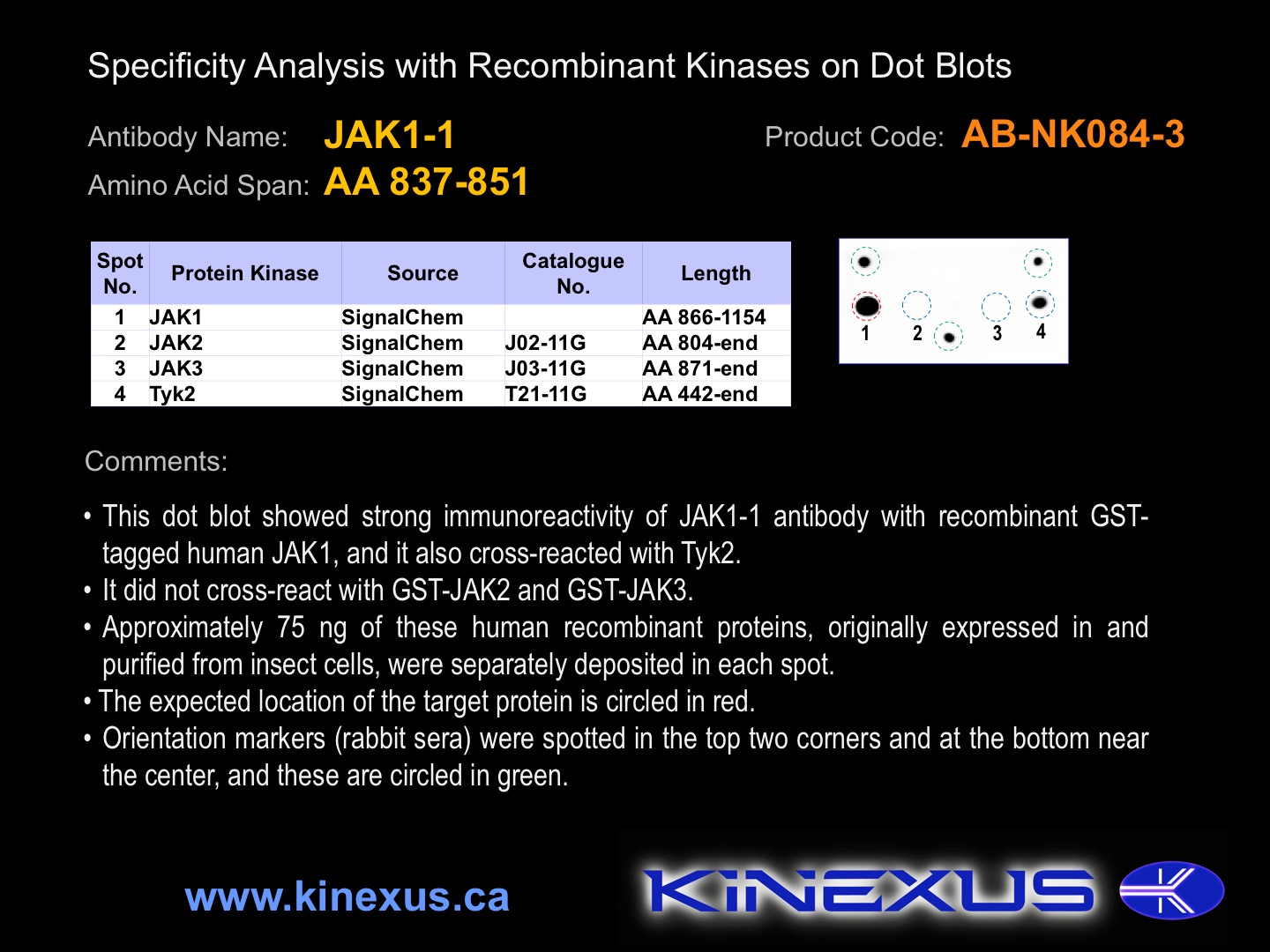Product Name: JAK1-1
Product Number: AB-NK084-3
| Size: | 25 µg | Price: | 89.00 | |
| $US |
Target Full Name: Janus protein-tyrosine kinase 1
Target Alias: JAK1A; Janus kinase 1; JAK1B; CE2.7.10.2; JAK-1; JTK3; JAK1_ENST00000342505; CCDS41346; Q0VGA4; Q4LDX3; Q6P669; Q8IV82; ENSG00000162434
Product Type Specific: Protein kinase pan-specific antibody
Antibody Code: NK084-3
Antibody Target Type: Pan-specific
Protein UniProt: P23458
Protein SigNET: P23458
Antibody Type: Polyclonal
Antibody Host Species: Rabbit
Antibody Immunogen Source: Human JAK1 sequence peptide Cat. No.: PE-01AUM99
Target Alias: JAK1A; Janus kinase 1; JAK1B; CE2.7.10.2; JAK-1; JTK3; JAK1_ENST00000342505; CCDS41346; Q0VGA4; Q4LDX3; Q6P669; Q8IV82; ENSG00000162434
Product Type Specific: Protein kinase pan-specific antibody
Antibody Code: NK084-3
Antibody Target Type: Pan-specific
Protein UniProt: P23458
Protein SigNET: P23458
Antibody Type: Polyclonal
Antibody Host Species: Rabbit
Antibody Immunogen Source: Human JAK1 sequence peptide Cat. No.: PE-01AUM99
Antibody Immunogen Sequence: CFFRAIMRDINKLEEQ
Antibody Immunogen Description: Corresponds to amino acid residues F837 to Q851; Kinase last alpha-chain
Production Method: The immunizing peptide was produced by solid phase synthesis on a multipep peptide synthesizer and purified by reverse-phase hplc chromatography. Purity was assessed by analytical hplc and the amino acid sequence confirmed by mass spectrometry analysis. This peptide was coupled to KLH prior to immunization into rabbits. New Zealand White rabbits were subcutaneously injected with KLH-coupled immunizing peptide every 4 weeks for 4 months. The sera from these animals was applied onto an agarose column to which the immunogen peptide was thio-linked. Antibody was eluted from the column with 0.1 M glycine, pH 2.5. Subsequently, the antibody solution was neutralized to pH 7.0 with saturated Tris.
Antibody Immunogen Description: Corresponds to amino acid residues F837 to Q851; Kinase last alpha-chain
Production Method: The immunizing peptide was produced by solid phase synthesis on a multipep peptide synthesizer and purified by reverse-phase hplc chromatography. Purity was assessed by analytical hplc and the amino acid sequence confirmed by mass spectrometry analysis. This peptide was coupled to KLH prior to immunization into rabbits. New Zealand White rabbits were subcutaneously injected with KLH-coupled immunizing peptide every 4 weeks for 4 months. The sera from these animals was applied onto an agarose column to which the immunogen peptide was thio-linked. Antibody was eluted from the column with 0.1 M glycine, pH 2.5. Subsequently, the antibody solution was neutralized to pH 7.0 with saturated Tris.
Antibody Modification: Unconjugated. Contact KInexus if you are interest in having the antibody biotinylated or coupled with fluorescent dyes.
Storage Buffer: Phosphate buffered saline pH 7.4, 0.05% Thimerasol
Storage Conditions: For long term storage, keep frozen at -40°C or lower. Stock solution can be kept at +4°C for more than 3 months. Avoid repeated freeze-thaw cycles.
Product Use: Western blotting | Antibody microarray
Antibody Dilution Recommended: 1 µg/ml for immunoblotting
Antibody Species Reactivity: Human; Mouse
Antibody Positive Control: The observed molecular mass of the processed target protein on SDS-PAGE gels is reported to be around 125-135 kDa.
Storage Buffer: Phosphate buffered saline pH 7.4, 0.05% Thimerasol
Storage Conditions: For long term storage, keep frozen at -40°C or lower. Stock solution can be kept at +4°C for more than 3 months. Avoid repeated freeze-thaw cycles.
Product Use: Western blotting | Antibody microarray
Antibody Dilution Recommended: 1 µg/ml for immunoblotting
Antibody Species Reactivity: Human; Mouse
Antibody Positive Control: The observed molecular mass of the processed target protein on SDS-PAGE gels is reported to be around 125-135 kDa.
Antibody Cross Reactivity: No immunoreactivity on protein dot blots with recombinant human JAK2, JAK3 and Tyk2.
Related Product 1: JAK1-1 blocking peptide
Related Product 2: JAK1-3 pan-specific antibody (Cat. No.: AB-NK084-5)
Related Product 3: JAK1-Y1022-phosphospecific antibody (Cat. No.: AB-PK126)
Related Product 1: JAK1-1 blocking peptide
Related Product 2: JAK1-3 pan-specific antibody (Cat. No.: AB-NK084-5)
Related Product 3: JAK1-Y1022-phosphospecific antibody (Cat. No.: AB-PK126)
Scientific Background: JAK1 is a protein-tyrosine kinase of the TK group and JAKA family. It is a non-receptor kinase that functions in the IFN-alpha/beta/gamma intracellular signal pathway. JAK1 has also been shown to interact with the interleukin-2 (IL-2) receptor. The JAK1 protein is typically membrane-associated and is widely expressed across different tissues. JAK1 also functions upstream of STAT transcription factors, specifically STAT3, acting to activate the proteins and promote gene transcription. Phosphorylation of Y940 inhibits phosphotransferase activity. JAK1 may be an oncoprotein (OP). Abnormal activity of STAT3 is implicated in the oncogenesis of several cancer types, including colorectal cancer and non-small cell lung cancer. JAK1 has been implicated in promoting the survival, invasion, and migration of colorectal cancer and non-small cell lung cancer cells due to over activation of STAT transcription factors resulting in the aberrant expression of certain downstream genes, such as Bcl-2, p21, p27, E-cadherin, VEGF, and MMPs. In addition, somatic mutations in the JAK1 gene have been observed in patients with acute myeloid leukemia (AML), including both T478S and V623A substitution mutations. The mutant JAK1 proteins displayed significantly enhanced activation of downstream STAT1 in response to type 1 interferon treatment, as well as increased activation of multiple dowstream intracellular signalling pathways. Truncating mutations of JAK1 have been observed in several cancer types, with 68% of the specimens coming from gynecologic cancers. Cancer cells with mutant truncated JAK1 protein are defective in IFN-gamma induced expression of LMP2 and TAP1, which inhibits the presentation of tumour antigens to be recognized by the immune system. Therefore, these truncating mutations are hypothesized to promote the ability of tumour cells to evade the immune system, enabling tumour survival.
© Kinexus Bioinformatics Corporation 2017


